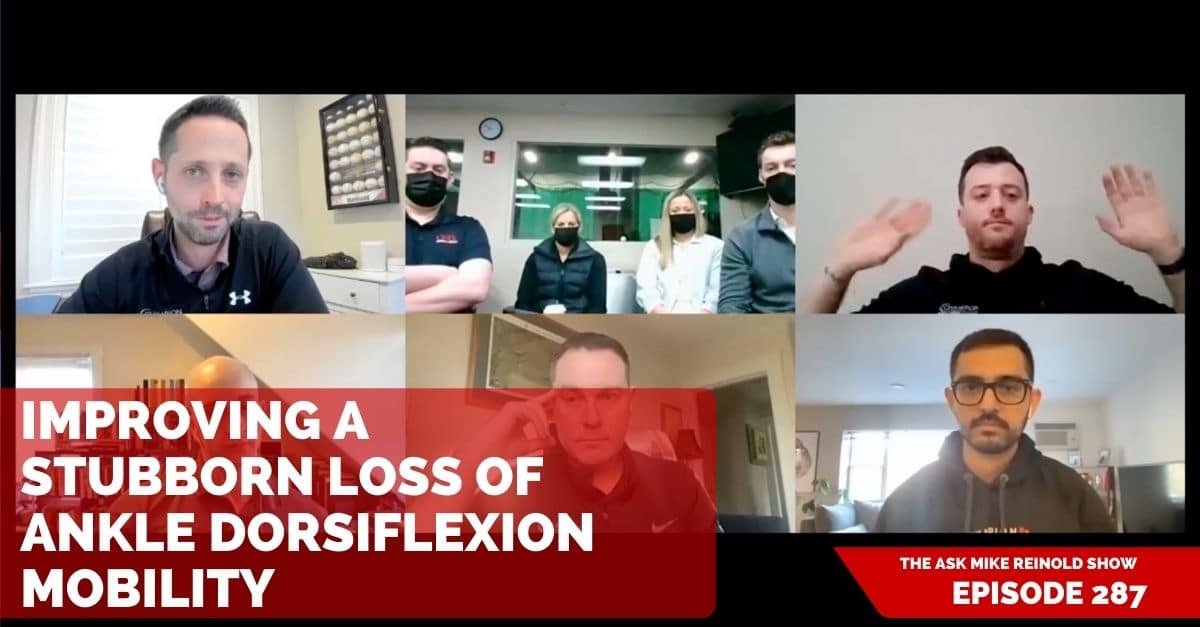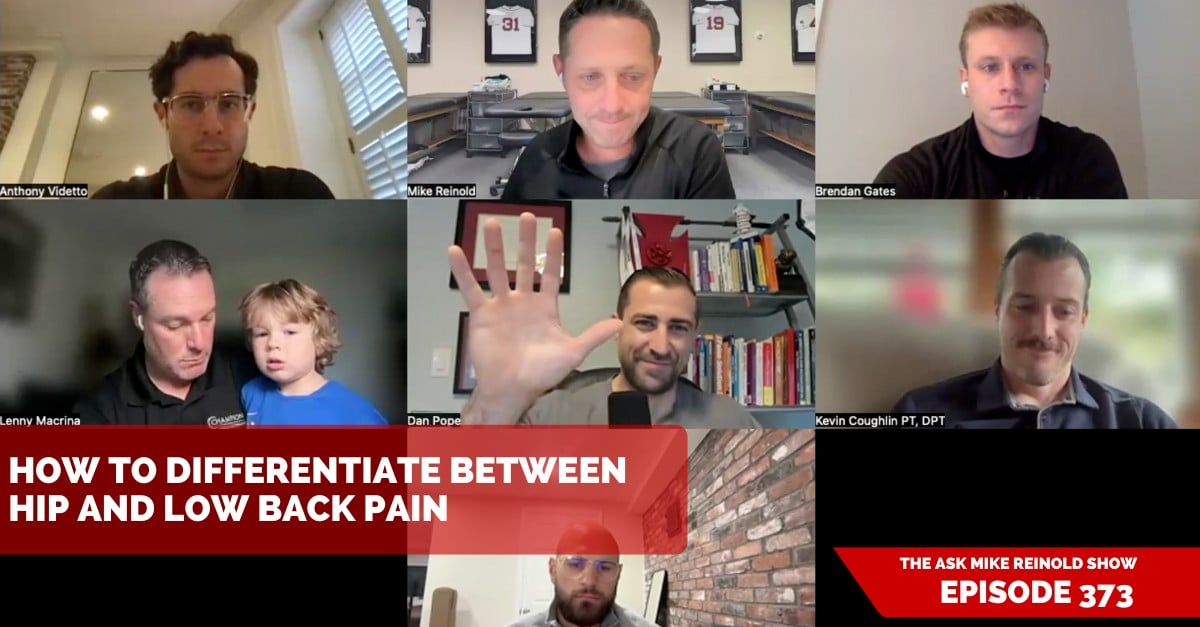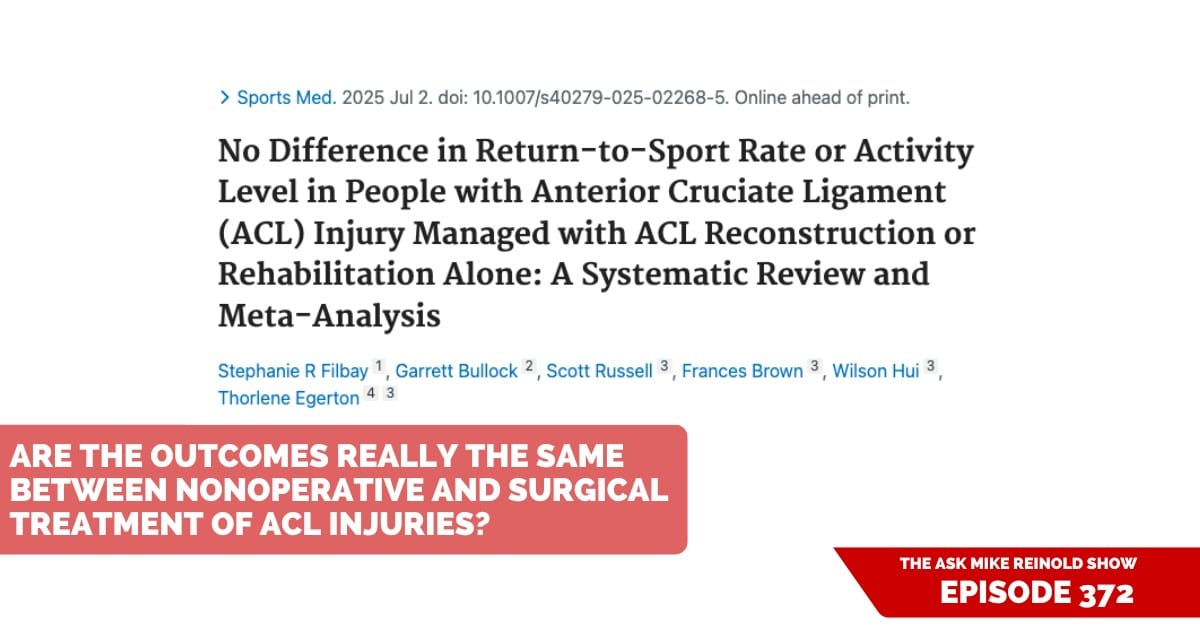Wouldn’t it be nice if we could just whip out a couple of simple mobility drills and always make a big difference in someone’s mobility?
I wish it were that easy!
Ankle dorsiflexion is one of those motions that can have many reasons why there are limitations.
Here’s how we handle a situation where someone has tried a bunch of ankle mobility drills and is still having issues with gaining mobility.
To view more episodes, subscribe, and ask your questions, go to mikereinold.com/askmikereinold.
#AskMikeReinold Episode 287: Improving a Stubborn Loss of Ankle Dorsiflexion Mobility
Listen and Subscribe to Podcast
You can use the player below to listen to the podcast or subscribe. If you are enjoying the podcast, PLEASE click here to leave us a review in iTunes, it will really mean a lot to us. THANKS!
Show Notes
Transcript
Student:
It can be Aliyah today. I’ll be Aliyah. We got Karen from New Zealand, says, “All the ankle mobility exercises I’ve ever seen, tried make virtually no difference to my somewhat limited ankle dorsiflexion. They help my right ankle though. When I try the most common mobility exercises, I feel a restriction in my left tip, not my calf or ankle, but I’ve never heard or seen anything about how the hip is involved. What is the relationship between hip range of motion and ankle dorsiflexion?”
Mike Reinold:
All right. Good question. Karen from New Zealand. I like that. I want to answer the question about just improving ankle dorsiflexion mobility in general here too, because I’m not sure where it’s going to go with the hip part. I mean, if you reel in your hip pinch, when you’re doing the dorsiflexion mobility drills, I’m not sure. Well, we answer [inaudible 00:02:50]. I think the position you’re putting yourself in which we may just need to adjust. So that’s an interesting part, but why don’t we start with that and knock that out real quick. But if she’s feeling a pinch in her hip doing ankle dorsiflexion modes, I’m going to assume that’s almost like a half kneeling position, right? She’s doing a bit of a lunch. So she’s getting a little bit of like hip flexion, stuff like that. That’s probably doing… Diwesh, if you’re in the gym and a client’s saying I can’t do any of my ankle dorsiflexion mobility drills without getting a pinch in my hip. What’s the first thing you do?
Diwesh Poudyal:
I just shorten up their half kneeling stance. They can really tilt a little bit more so that we’re actually trying to bias the front ankle. And I see that’s happening. People that do it standing in split stands and in half kneeling, I think both are fairly common in some people that are a little bit restricted in the hip, or maybe even have some FAI type stuff. So I just make them go back knee closer to their front heel and then go forward.
Mike Reinold:
Right. So you can switch them up from half kneeling to a standing position, cause anything standing would probably be a good way of doing it. That’d be interesting. I like that. I wonder too, if we’re getting stuck like in the sagittal plane. And we think that we have to be in the sagittal plane, but theoretically, if we’re working on hip, or excuse me, ankle mobility, right? The only thing that probably matters is that the tibia, your chin and your foot are in the same plane together. It doesn’t really matter if your hip’s in the sagittal plane. So maybe she can widen her hips a little bit. And get her hip in a more comfortable position and then make sure she’s still doing that straight plane dorsiflexion mode.
Mike Reinold:
Those would be two potential things that I would come up with. And I wanted to hit that part of the question, Karen, because I like that part of the question. It just shows is, I wouldn’t give up on any drill. I would try to find a way to modify it. So that way you can work it around it a little bit. I think the first thing we would always do is let’s find a position or maybe a variation of a drill that maybe a little bit more comfortable or something that you could succeed in a better position. And I think I would start with that first versus, “Oh, these don’t work” or “I’m going to stop doing this because it hurts my hip”. I’m not sure if it’s that related. Now let’s dig into the real question though. She’s having trouble getting her ankle dorsiflexion mobility going, even though she’s doing some of these drills. So I’m trying to guess if Dave wants to start with this one. I’m not a hundred percent sure. Dave, you want to start with this one here too? And then I’m sure Dave and Kevin have seen this a ton with people, Kevin does a lot of runners and I’m sure some people are dealing with this off. What do you think, Dave?
Dave Tilley:
I will quickly just say this. I deal with a lot of gymnasts and people who are impact athletes. And so I have seen many ankles that are stiff and don’t move and stuff like that. I don’t know why the timing in this episode works out. I’m reading a book about the foot and there’s a lot of discussion about talar dome, shape and anatomy. And I can tell you that if you have very unique anatomy or a sport history that you’ve put a lot of mileage, no pun intended for Kevin, on your ankles, that it’s very possible that the osseus shape of your talar dome and the way it interacts with the mortise has changed and it’s preventing a good gliding. So I made this mistake when I was in college as an athlete. And I know a lot of athletes who have continued you to train through this, they’re just trying to do mobility work.
Dave Tilley:
They’re trying to do like really aggressive kettlebell on their knee, over pressure, all this kind of stuff. If your bones themselves have maybe changed the shape and congruency because of past injuries or ankle sprains or stuff like that, this could be a true inherent limitation. So I would just caution you against continuing to really go hard on ankle mobility. Maybe get an x-ray, maybe get some sort of a consult, to make sure because if you want to get it dealt with that’s cool. But if not, just accept it and maybe figure out training modifications, or figure out other ways that you can work around. There’s nothing wrong with heel elevating your squats for the rest of your life and going to parallel and just being happy. Especially if you have health issue. Unless you’re in a lead gymnast, I wouldn’t worry about it.
Mike Reinold:
Right. Who even knows what the dorsiflexion is? Sometimes people just work on something that they probably don’t even need to work on. It’s not the end of the world if you don’t have symmetrical ankle dorsiflexion mobility. If your lack of mobility is impacting an activity you want to do, then yeah. That’s a different conversation. But I like how Dave started that off. I was definitely thinking, “Well, everybody’s anatomically a little bit different, so maybe they have something there”, but I do like that. There’s so many people, even if you’re not an impact athlete with gymnastics or running or jumping type thing, if you’re not an impact athlete, even just recurring ankle sprains that you could have done in as a youth, just like spreading your ankle at recess over and over again over time, that could cause some adaptations that are limiting your dorsiflexion. So I like that. Kevin, anything you want to add to that from your experience with your runners and stuff? If somebody comes to you and says that, what’s the first thing you’re going to think of?
Kevin Coughlin:
Yeah. So thing is, I’m curious how she’s assessing her own dorsiflexion motion. I think a lot of times it maybe feels stiff, but she’s maybe not objectively figuring out how limited it might be compared to her other side. So I think one thing I would do to start is maybe teach her like the half kneeling dorsiflexion test, against the wall. And I think generally we want to see almost a fist width between your foot and the wall, where you can clad your tibia forward and keep your heel flat. So I’d start out by figuring out how far away from the wall she might be with that type of test. And then, this is something I learned from Dan, but you see people all the time say, “X or Y mobility drill doesn’t work for me”, but there’s no reassessment.
Kevin Coughlin:
So maybe she needs to work on say, forwarding her calf and make sure she’s doing it at the right dosage. So maybe one minute per day, five to seven days per week type thing, following it up with maybe a static stretch for the same type of duration. And then maybe we add in some eccentric calf exercises. I find those three, as a recipe, work really well for improving mobility, but then you have to go back and recheck your mobility and see am I making a change or not?
Kevin Coughlin:
And then I think another important thing is when she’s doing that test where she feels the limitation, if there’s a limitation in the back of the calf, like soleus, maybe it’s more soft tissue related, but to Dave’s point, if she’s feeling like a pinchy pain or limitation in the front of her ankle, at her talocrural joint, it’s probably not something that you’re going to improve on your own. And I’d caution people against grabbing mobility and trying to torque their joint and improve, perform joint mobility stuff on their own because it could be an anatomical restriction. It could be a past injury. So I’d say, if you’re really feeling a limitation in the front of the ankle, that’s when I seek out a physical therapist and try to figure out why you’re limited there. And if there’s something they could do to help you.
Mike Reinold:
I like that. Guidance through this process to try to figure this out is probably going to be best. We probably need to dig in a little bit deeper and figure out exactly what’s going on, what the limitation is and why, and then find that path for her. I think that’s a real critical key. What I like that you said there too, Kev, was that there’s a chance he’s maybe just putting maybe one or two ingredients into that recipe and not the correct ones or maybe not even the correct dosage of them that it’s all about assessing and reassessing. That’s one thing we do really good at Champion, I think, that we’ve tried to systemize here is that, we don’t just provide a treatment.
Mike Reinold:
What we do is we assess, we provide a treatment then reassess to see what it did. Did it work? If it didn’t work, let’s dig back in and figure out what else we need to do. If it did work, great. Move on to the next thing. Don’t keep going at it. Just because in your head, you thought, “I wanted to get to the eight minute mark or something”, that’s irrelevant, but not to get off topic. But for me, I think it’s about making sure she has the right dose. I think that’s important. Dewey, did you want to add to that?
Diwesh Poudyal:
Yeah, just a couple things to add on to what Kevin said. Cause I think definitely figuring out what’s causing the limitation or maybe what are some reasons that we might see a limitation are very important. Kevin obviously mentioned the soleus and then the joint in the front. The other two that I’ve noticed quite a bit and one may be a little bit lost on a lot of people. I find that people that can’t pronate well often don’t get good dorsiflexion. If someone has a very stiff arch in their foot and they try to do all these dorsiflexion drills, but that foot’s not actually pronating a little bit before the tibia glides forward, you’re not really getting a whole lot of dorsiflexion. So people that forget to assess what’s happening at the foot, maybe running into a little bit of trouble as well.
Diwesh Poudyal:
And then the other one too, that I see quite a bit, and I know me and Dave have talked about this quite a bit, is actually the anterior tib. I think a lot of people that have weakness in the anterior tib or maybe have trouble controlling it. And for some people I think it might be because of their frequent heel striking on foot contact when they’re running and stuff, that matches start to stiffen. But also probably, put down a joint tension relationship where the anterior tib is just locked down and stuck in one place. So I’ve had quite a bit of success working on eccentric lowering and maybe even just direct into a strengthening that’ll all of a sudden improve ankle mobility. And then lastly, I think people also forget the whole add load to the equation part of it. I think people do mobility, mobility and mobility. Well, if you’re not actually spending time in a deep squat or a deep lunge that actually requires this dorsiflexion and then maybe even a higher velocity, higher load stuff like running and jumping, then you’re not really going to get that mobility to stick. Cause your body doesn’t have a reason to keep it. So you give your body that reason by giving some sort of a loaded position to work on it over time.
Mike Reinold:
Yeah. It makes sense. And I like the way you get add up all those variables. And that’s, again, with the assessment part, it’s really deep. There may be something else that’s limiting that ankle dorsiflexion. And you’re absolutely right. Foot mechanics play a big part in that as well. I think the big key is, we need to guide her. We need to dig in a little bit deeper. And this is one of the things where sometimes early career professionals and PT world and the fitness world, maybe they get a little frustrated sometimes that they’re not seeing immediate results, but we always say, “Look, do your vow, do your assessment process, come up with an intelligent program to see what’s working, but then reassess to see if it’s not working. And if it’s not, don’t feel bad, take a step back, look a little deeper.”
Mike Reinold:
I think that’s the key is, sometimes the majority of people will get better with some of the basics, but sometimes you have to dig a little bit deeper with some people. And Karen’s one of those people we need to dig a little deeper with. So like a really good example, it’s okay to give it a good solid shot and maybe not get the outcomes that you’re expecting right away, but just know that, “Okay, all right. It’s time to dig a little deeper because she’s not responding the way I thought she would.” And then that’s where you start to like kind of chase that out a little bit. And I think that’s an appropriate process that we all go through, even us experience clinicians.
Mike Reinold:
So I kind of keep that in mind too, for some of those people. I know it seems like it’s, “Well, you just do this drill. I saw this on Instagram. It should work.” And then it doesn’t and you see that on so many people. It can get frustrating at times. Awesome. Karen hope that helps. Thanks for the question. I really appreciate that. If you have another question, head to mikereinold.com, click on that podcast link and fill out the form to ask your own question and be sure to head to Apple podcast, Spotify. Rate, review, subscribe so you can catch our next episode and we will see you in the future.





